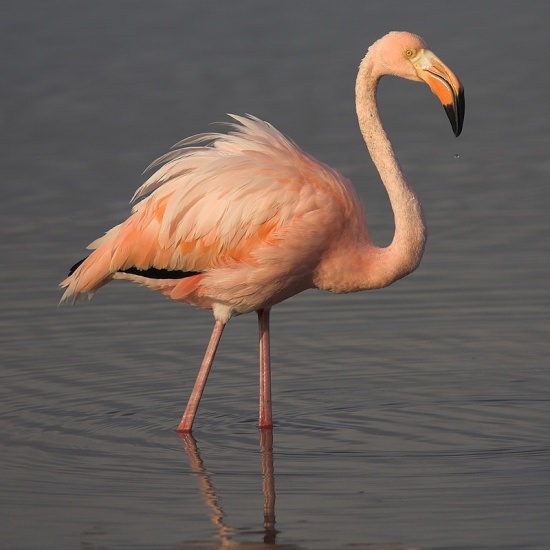(User template, Bird Song Category, some deleted text replaced) |
|||
| Line 1: | Line 1: | ||
| − | [[Image:Caribbean_Flamingo.jpg|thumb|550px|right|Photo by Momo | + | [[Image:Caribbean_Flamingo.jpg|thumb|550px|right|Photo by {{user|Momo|Momo}} <br />Locality: Isla Floreana, [[Galapagos]], [[Ecuador]]]] |
;[[:Category:Phoenicopterus|Phoenicopterus]] ruber | ;[[:Category:Phoenicopterus|Phoenicopterus]] ruber | ||
'''Alternative name: American Flamingo''' | '''Alternative name: American Flamingo''' | ||
| − | |||
| − | |||
==Identification== | ==Identification== | ||
120-145 cm. Deep pink- orange plumage, bill - black tip, red-orange middle, pale yellow near eye, long neck and legs, light yellow iris. | 120-145 cm. Deep pink- orange plumage, bill - black tip, red-orange middle, pale yellow near eye, long neck and legs, light yellow iris. | ||
| Line 11: | Line 9: | ||
Often considered conspecific with the [[Greater Flamingo]] (''Phoenicopterus roseus'') of [[Europe]], [[Asia]], and [[Africa]]. | Often considered conspecific with the [[Greater Flamingo]] (''Phoenicopterus roseus'') of [[Europe]], [[Asia]], and [[Africa]]. | ||
==Habitat== | ==Habitat== | ||
| − | + | Feeds in shallow lagunes, preferably with high salinity. As such they cannot breed every year in all colonies, as the lagunes can be too dry if the rain is lacking. | |
==Behaviour== | ==Behaviour== | ||
| − | Breed in large colonies | + | ====Breeding==== |
| − | + | Breed in large colonies in nests that consists of mud compacted into a mound on top of which the nest of mud and twigs is situated, this is built by both sexes. 1 white egg is laid, and incubated by both parents for 27-31 days. | |
| − | + | ====Diet==== | |
The diet includes small crustaceans, molluscs, and insects. | The diet includes small crustaceans, molluscs, and insects. | ||
| − | + | ====Vocalisation==== | |
| − | == | ||
<flashmp3>Phoenicopterus ruber (song).mp3</flashmp3><br /> | <flashmp3>Phoenicopterus ruber (song).mp3</flashmp3><br /> | ||
''[[Media:Phoenicopterus ruber (song).mp3|Listen in an external program]]'' | ''[[Media:Phoenicopterus ruber (song).mp3|Listen in an external program]]'' | ||
| − | |||
==References== | ==References== | ||
Colorado Education | Colorado Education | ||
| Line 27: | Line 23: | ||
Note: Results in photo search may include photos of ''Phoenicopterus roseus'', which previously was considered a subspecies of this species (''see Taxonomy''). | Note: Results in photo search may include photos of ''Phoenicopterus roseus'', which previously was considered a subspecies of this species (''see Taxonomy''). | ||
{{GSearch|Phoenicopterus+ruber}} | {{GSearch|Phoenicopterus+ruber}} | ||
| − | [[Category:Birds]][[Category:Phoenicopterus]] | + | [[Category:Birds]][[Category:Phoenicopterus]][[Category:Bird Songs]] |
Revision as of 21:12, 13 March 2009
- Phoenicopterus ruber
Alternative name: American Flamingo
Identification
120-145 cm. Deep pink- orange plumage, bill - black tip, red-orange middle, pale yellow near eye, long neck and legs, light yellow iris.
Distribution
Caribbean and Mexico to Brazil and Galapagos Islands Ecuador. Within the Caribbean probably most numerous in Cuba and Bahamas.
Taxonomy
Often considered conspecific with the Greater Flamingo (Phoenicopterus roseus) of Europe, Asia, and Africa.
Habitat
Feeds in shallow lagunes, preferably with high salinity. As such they cannot breed every year in all colonies, as the lagunes can be too dry if the rain is lacking.
Behaviour
Breeding
Breed in large colonies in nests that consists of mud compacted into a mound on top of which the nest of mud and twigs is situated, this is built by both sexes. 1 white egg is laid, and incubated by both parents for 27-31 days.
Diet
The diet includes small crustaceans, molluscs, and insects.
Vocalisation
<flashmp3>Phoenicopterus ruber (song).mp3</flashmp3>
Listen in an external program
References
Colorado Education
External Links
Note: Results in photo search may include photos of Phoenicopterus roseus, which previously was considered a subspecies of this species (see Taxonomy).




